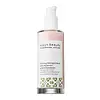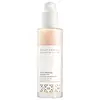What's inside
What's inside
 Key Ingredients
Key Ingredients

 Benefits
Benefits

 Concerns
Concerns

 Ingredients Side-by-side
Ingredients Side-by-side

Water
Skin ConditioningGlycerin
HumectantCetearyl Alcohol
EmollientBrassicyl Isoleucinate Esylate
Emulsion StabilisingPrunus Amygdalus Dulcis Oil
Skin ConditioningHelianthus Annuus Seed Oil
EmollientAloe Barbadensis Leaf Juice
Skin ConditioningBrassica Alcohol
EmollientGlyceryl Stearate
EmollientBakuchiol
AntimicrobialMelatonin
AntioxidantTaraxacum Officinale Extract
Skin ConditioningVaccinium Uliginosum Berry Extract
Skin ConditioningPrunus Davidiana Extract
AntioxidantChamomilla Recutita Flower Extract
MaskingArnica Montana Extract
Skin ConditioningBorago Officinalis Extract
EmollientSalvia Officinalis Leaf Extract
CleansingCalendula Officinalis Flower Extract
MaskingArctostaphylos Uva-Ursi Leaf Extract
Skin ConditioningSalix Alba Bark Extract
AstringentLactic Acid
BufferingColloidal Oatmeal
AbsorbentSqualane
EmollientCaprylhydroxamic Acid
Citrus Aurantium Bergamia Fruit Oil
MaskingArginine
MaskingCaprylyl Glycol
EmollientOleyl Lactate
EmollientLavandula Angustifolia Oil
MaskingSodium Hyaluronate
HumectantButyrospermum Parkii Butter
Skin ConditioningMangifera Indica Seed Butter
Skin ConditioningSimmondsia Chinensis Seed Oil
EmollientCentella Asiatica Extract
CleansingHydrolyzed Gardenia Florida Extract
AntioxidantMaltodextrin
AbsorbentValeriana Officinalis Root Extract
Skin ConditioningPropanediol
SolventChlorella Vulgaris Extract
Skin ConditioningTasmannia Lanceolata Fruit/Leaf Extract
AntioxidantWater, Glycerin, Cetearyl Alcohol, Brassicyl Isoleucinate Esylate, Prunus Amygdalus Dulcis Oil, Helianthus Annuus Seed Oil, Aloe Barbadensis Leaf Juice, Brassica Alcohol, Glyceryl Stearate, Bakuchiol, Melatonin, Taraxacum Officinale Extract, Vaccinium Uliginosum Berry Extract, Prunus Davidiana Extract, Chamomilla Recutita Flower Extract, Arnica Montana Extract, Borago Officinalis Extract, Salvia Officinalis Leaf Extract, Calendula Officinalis Flower Extract, Arctostaphylos Uva-Ursi Leaf Extract, Salix Alba Bark Extract, Lactic Acid, Colloidal Oatmeal, Squalane, Caprylhydroxamic Acid, Citrus Aurantium Bergamia Fruit Oil, Arginine, Caprylyl Glycol, Oleyl Lactate, Lavandula Angustifolia Oil, Sodium Hyaluronate, Butyrospermum Parkii Butter, Mangifera Indica Seed Butter, Simmondsia Chinensis Seed Oil, Centella Asiatica Extract, Hydrolyzed Gardenia Florida Extract, Maltodextrin, Valeriana Officinalis Root Extract, Propanediol, Chlorella Vulgaris Extract, Tasmannia Lanceolata Fruit/Leaf Extract
Water
Skin ConditioningGlycerin
HumectantSodium Cocoyl Isethionate
CleansingSodium Hyaluronate
HumectantSodium Methyl Cocoyl Taurate
CleansingCetearyl Alcohol
EmollientLactobacillus/Punica Granatum Fruit Ferment Extract
Skin ConditioningPolyacrylate-33
Sodium Cocoyl Apple Amino Acids
Skin ConditioningDehydroacetic Acid
PreservativeBenzyl Alcohol
PerfumingTromethamine
BufferingCarica Papaya Fruit Extract
Skin ConditioningPotassium Sorbate
PreservativeEclipta Prostrata Extract
Skin ConditioningMelia Azadirachta Leaf Extract
Skin ConditioningMoringa Oleifera Seed Oil
EmollientGlycolic Acid
BufferingLactic Acid
BufferingAscorbic Acid
AntioxidantLinoleic Acid
CleansingSimmondsia Chinensis Seed Oil
EmollientLavandula Angustifolia Oil
MaskingCitrus Aurantium Dulcis Oil
MaskingSalvia Officinalis Leaf Extract
CleansingArnica Montana Flower Extract
MaskingBorago Officinalis Extract
EmollientCalendula Officinalis Flower Extract
MaskingChamomilla Recutita Flower Extract
MaskingCeramide Ng
Skin ConditioningAlcohol
AntimicrobialWater, Glycerin, Sodium Cocoyl Isethionate, Sodium Hyaluronate, Sodium Methyl Cocoyl Taurate, Cetearyl Alcohol, Lactobacillus/Punica Granatum Fruit Ferment Extract, Polyacrylate-33, Sodium Cocoyl Apple Amino Acids, Dehydroacetic Acid, Benzyl Alcohol, Tromethamine, Carica Papaya Fruit Extract, Potassium Sorbate, Eclipta Prostrata Extract, Melia Azadirachta Leaf Extract, Moringa Oleifera Seed Oil, Glycolic Acid, Lactic Acid, Ascorbic Acid, Linoleic Acid, Simmondsia Chinensis Seed Oil, Lavandula Angustifolia Oil, Citrus Aurantium Dulcis Oil, Salvia Officinalis Leaf Extract, Arnica Montana Flower Extract, Borago Officinalis Extract, Calendula Officinalis Flower Extract, Chamomilla Recutita Flower Extract, Ceramide Ng, Alcohol
 Reviews
Reviews

Ingredients Explained
These ingredients are found in both products.
Ingredients higher up in an ingredient list are typically present in a larger amount.
Borago Officinalis Extract is often synonymous with Borago Officinalis Seed Oil. It comes from the seeds of the starflower plant. This plant grows primarily in Europe.
This oil does not have a scent. It contains fatty acids such as linolenic acid. These fatty acids help keep skin hydrated.
Borago Officinalis Seed Oil is an antioxidant. Antioxidants help fight free-radicals. Free-radicals are molecules that may damage your skin cells.
Learn more about Borago Officinalis ExtractCalendula Officinalis Flower Extract comes from the common Marigold plant. This ingredient is a skin conditioner.
Marigolds contain flavonoids. Flavonoids are a group of substances found naturally in plants. They possess antioxidant and inflammation properties.
This ingredient soothes skin inflammation by inhibiting inhibiting a part of the inflammation process.
Marigolds have been used in traditional medicine throughout Asia and Europe.
Learn more about Calendula Officinalis Flower ExtractCetearyl alcohol is a mixture of two fatty alcohols: cetyl alcohol and stearyl alcohol. It is mainly used as an emulsifier. Emulsifiers help prevent the separation of oils and products. Due to its composition, it can also be used to thicken a product or help create foam.
Cetearyl alcohol is an emollient. Emollients help soothe and hydrate the skin by trapping moisture.
Studies show Cetearyl alcohol is non-toxic and non-irritating. The FDA allows products labeled "alcohol-free" to have fatty alcohols.
This ingredient is usually derived from plant oils such as palm, vegetable, or coconut oils. There is debate on whether this ingredient will cause acne.
Due to the fatty acid base, this ingredient may not be Malassezia folliculitis safe.
Learn more about Cetearyl AlcoholChamomilla Recutita Flower Extract comes from the Chamomile flower.
Chamomile is rich in antioxidants and has anti-inflammatory properties. Several compounds found in chamomile help with soothing, such as bisbolol.
Antioxidant components in chamomile make it an effective ingredient to help slow the signs of aging. Antioxidants help fight free-radical molecules, or molecules that may damage your skin.
Essential oils from chamomile have been found to improve wound healing due to its antimicrobial properties.
Ancient Greeks and Egyptians used Chamomile to treat skin redness and dryness. Chamomile has also been used to help treat stomach issues.
Learn more about Chamomilla Recutita Flower ExtractGlycerin is already naturally found in your skin. It helps moisturize and protect your skin.
A study from 2016 found glycerin to be more effective as a humectant than AHAs and hyaluronic acid.
As a humectant, it helps the skin stay hydrated by pulling moisture to your skin. The low molecular weight of glycerin allows it to pull moisture into the deeper layers of your skin.
Hydrated skin improves your skin barrier; Your skin barrier helps protect against irritants and bacteria.
Glycerin has also been found to have antimicrobial and antiviral properties. Due to these properties, glycerin is often used in wound and burn treatments.
In cosmetics, glycerin is usually derived from plants such as soybean or palm. However, it can also be sourced from animals, such as tallow or animal fat.
This ingredient is organic, colorless, odorless, and non-toxic.
Glycerin is the name for this ingredient in American English. British English uses Glycerol/Glycerine.
Learn more about GlycerinLactic Acid is another well-loved alpha hydroxy acid (AHA). It is gentler than glycolic acid but still highly effective.
Its main role is to exfoliate the surface of the skin by loosening the “glue” that holds dead skin cells together. Shedding those old cells leads to smoother, softer, and more even-toned skin.
Because lactic acid molecules are larger than glycolic acid, they don’t penetrate as deeply. This means they’re less likely to sting or irritate, making it a great choice for beginners or those with sensitive skin.
Like glycolic acid, it can:
Lactic acid also acts as a humectant (like hyaluronic acid). It can draw water into the skin to improve hydration and also plays a role in the skin's natural moisturizing factor (NMF) in the form of sodium lactate.
Studies show it can boost ceramide production to strengthen the skin barrier and even help balance the skin’s microbiome.
To get results, choose products with a pH between 3-4.
Lower strengths (5-12%) focus on surface exfoliation; higher strengths (12% and up) can reach deeper in the dermis (deeper, supportive layer) to improve skin texture and firmness over time.
Though it was originally derived from milk, most modern lactic acid used in skincare is vegan. It is made through non-dairy fermentation to create a bio-identical and stable form suitable for all formulations.
When lactic acid shows up near the end of an ingredient list, it usually means the brand added just a tiny amount to adjust the product’s pH.
Legend has it that Cleopatra used to bathe in sour milk to help reduce wrinkles.
Lactic acid is truly a gentle multitasker: it exfoliates, hydrates, strengthens, and brightens. It's a great ingredient for giving your skin a smooth, glowing, and healthy look without the harshness of stronger acids.
Read more about some other popular AHA's here:
Learn more about Lactic AcidLavandula Angustifolia Oil is more commonly known as lavender essential oil. It is considered a fragrancing ingredient.
Lavender imparts a famous scent. While the smell is lovely, this ingredient and may sensitize skin in topical products. This is because about 85% of the oil is made up of linalool and linalyl acetate.
When exposed to air, these two compounds become strong allergens. This ingredient exhibits cytotoxicity at low concentrations; amounts of 0.25% have been shown to damage skin cells.
A study from Japan found this ingredient caused lavender sensitivity after widespread exposure.
Lavender essential oil has some antimicrobial, antibacterial, and anti-inflammatory properties. However, the cons of this ingredient may outweight the pros.
More research is needed to confirm lavender essential oil's effects when used in aromatherapy.
Lavandula Angustifolia is known as the English Lavender and famous for creating purple fields in Provence, France.
Learn more about Lavandula Angustifolia OilSage leaf extract is a culinary and medicinal herb with antibacterial, antioxidant, and soothing properties.
This ingredient is made up of 75-90% ursolic acid, a potent antioxidant and anti-inflammatory compound.
This oil comes from the seeds of the desert shrub called Jojoba. It is more commonly known as jojoba oil, a non-comedogenic oil.
Jojoba oil does not contain fragrance and has many fatty-acids, making it a great soothing ingredient.
It also contains Vitamin E, a great moisturizing ingredient. Vitamin E is also an antioxidant and protects your skin against oxidative damage.
This ingredient humectant properties, meaning it helps draw moisture from the air. This helps keep your skin hydrated.
While jojoba has antibacterial properties, it is only able to kill some strains of bacteria.
Studies also show it helps in wound healing. In fact, Indigenous cultures have used jojoba as a moisturizer and to help treat burns for centuries.
Fun fact: Jojoba oil similar to natural human skin sebum, so it has a great effect on dry skin. It is also promising with helping to regulate sebum production.
Due to its fatty acid content, Jojoba oil may not be fungal acne safe. We recommend speaking with a professional if you have any concerns.
Learn more about Simmondsia Chinensis Seed OilSodium Hyaluronate is hyaluronic acid's salt form. It is commonly derived from the sodium salt of hyaluronic acid.
Like hyaluronic acid, it is great at holding water and acts as a humectant. This makes it a great skin hydrating ingredient.
Sodium Hyaluronate is naturally occurring in our bodies and is mostly found in eye fluid and joints.
These are some other common types of Hyaluronic Acid:
Learn more about Sodium HyaluronateWater. It's the most common cosmetic ingredient of all. You'll usually see it at the top of ingredient lists, meaning that it makes up the largest part of the product.
So why is it so popular? Water most often acts as a solvent - this means that it helps dissolve other ingredients into the formulation.
You'll also recognize water as that liquid we all need to stay alive. If you see this, drink a glass of water. Stay hydrated!
Learn more about Water